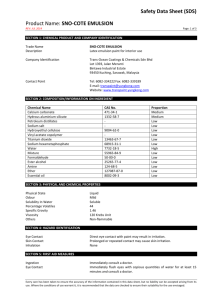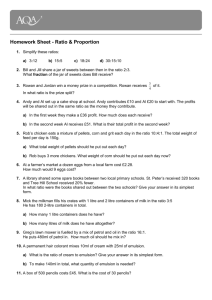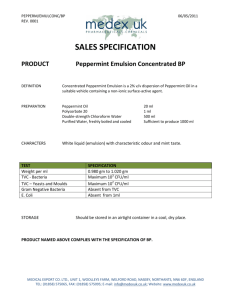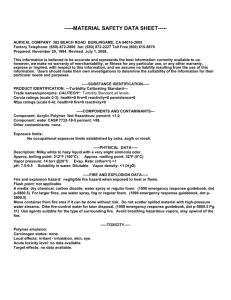Multidisciplinary Research in Transportation Surface Treatment Binder Construction Toolkit
advertisement
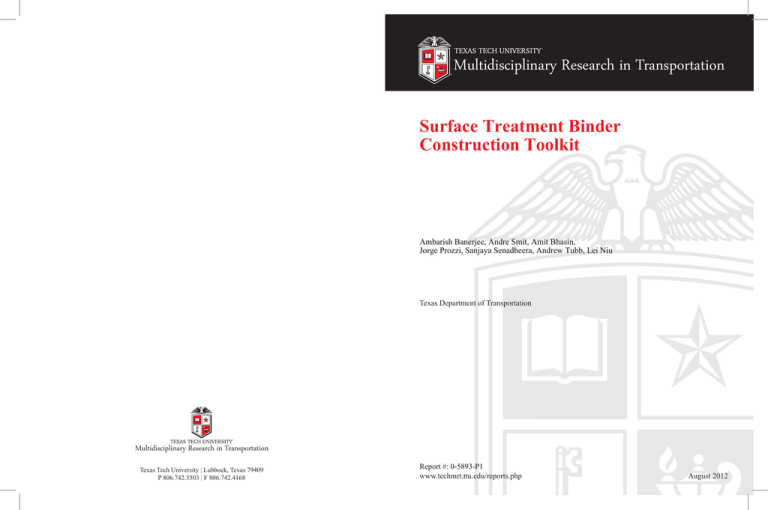
Multidisciplinary Research in Transportation Surface Treatment Binder Construction Toolkit Ambarish Banerjee, Andre Smit, Amit Bhasin, Jorge Prozzi, Sanjaya Senadheera, Andrew Tubb, Lei Niu Texas Department of Transportation Multidisciplinary Research in Transportation Texas Tech University | Lubbock, Texas 79409 P 806.742.3503 | F 806.742.4168 Report #: 0-5893-P1 www.techmrt.ttu.edu/reports.php August 2012 NOTICE The United States Government and the State of Texas do not endorse products or manufacturers. Trade or manufacturers’ names appear herein solely because they are considered essential to the object of this report. Surface Treatment Binder Construction Toolkit Ambarish Banerjee Andre Smit Amit Bhasin Jorge Prozzi Center for Transportation Research University of Texas at Austin Sanjaya Senadheera Center for Multidisciplinary Research in Transportation Texas Tech University Research Project 0-5893 Research Product 0-5893-P1 Conducted for the Texas Department of Transportation RECOMMENDED TEST PROTOCOL FOR DETERMINING THE DILUTION RATIO OF THE PLANT EMULSION AT THE CONSTRUCTION SITE SCOPE Use this test method to evaluate the dilution ratio of asphalt emulsions at the job location for the plant sample. APPARATUS A heating device in the form of a hot plate or a gas-oven with the option to control the temperature or heat flow. A measuring balance capable of measuring up to 500 grams with an accuracy of up to 0.1 gram. MATERIALS Deep labeled slip cover tin cans as shown in Figure 1, one can per test. Figure 1: 16 oz. deep labeled slip cover tins (Available at http://www.houseofcans.com/deep-style-p-525-l-en.html) PROCEDURE 1. Remove lid of deep slip cover tin can and weigh on the measuring balance. Note the weight (A). 2. Weigh approximately 30 grams of the emulsion from the transport truck into one of the deep slip cover tins. Note the combined weight of the tin can with the emulsion inside the can (B). 3. Note the type of emulsion being tested. Dilution ratio will differ considerably depending upon the type of emulsion. 4. Heat the can to a temperature between 140°C and 180°C (284° - 356°F) to boil the water off the emulsion. Temperature should be maintained in this range to avoid vigorous agitation of the emulsion due to the removal of water through boiling. This can cause the emulsion to spill out of the can and distort the final results. 1 5. Turn off the heat when a grayish smoke appears, which indicates the complete removal of water from the emulsion. Make sure the agitation due to boiling of water has also ceased, as there should no water left in the emulsion. 6. Remove the can from the heating device when the weight reaches a constant level and let it cool to the ambient temperature. 7. Weigh the can again to record the combined weight of the can and the residual asphalt left after complete removal of water (C). 8. Calculate the dilution ratio for the emulsion according to the guidelines provided below. 9. Conduct four replicate tests on the emulsion sample for each truckload of the material delivered to the job site. 10. Report the average and the coefficient of variation for each of the four sets of measurements. 11. Compare the average dilution ratio against Item 300 specifications according to the “Standard Specifications for Construction and Maintenance of Highways, Streets, and Bridges.” Report whether the material meets the requirements. CALCULATIONS Calculate the dilution ratio for the emulsion using the relation given below: ( ) Where, A = Weight of the empty deep slip cover tin can (in grams) B = Combined weight of the slip cover tin can and the emulsion (in grams) C = Combined weight of the empty slip cover tin can and the residue from the emulsion (in grams) Note 1: Reference Table 1 for maintaining records of the different weights that are being collected over the duration of the test Table 1: Weight Measurements Sample Weight of empty Combined weight of can and Combined weight of can and the # can (A) the emulsion sample (B) emulsion residue (C) 1 2 3 4 CoV: Std Dev(R1, R2, R3, R4)/Average(R1, Average: (R1+R2+R3+R4)/4 R2, R3, R4) ARCHIVED VERSIONS None 2 RECOMMENDED TEST PROTOCOL FOR DETERMINING THE VISCOSITY OF THE PLANT EMULSION AT THE CONSTRUCTION SITE USING SHELL CUPS SCOPE Use this test method to evaluate the viscosity of asphalt emulsions at the job location for the plant sample. APPARATUS AND MATERIALS Shell cup sizes 3, 3.5, 5 and 6 from Norcross Corporation with at least 3 cups for each of the four different sizes. Figure 2 shows a Shell cup #3. Temperature control unit in the form of a water bath or an insulating material, capable of keeping the temperature of the sample steady (within ±9°F) while conducting the experiment in the material. Measure time with a stopwatch to record time taken for the emulsion to drain through the orifice in the Shell cups. Use a temperature gun or thermocouple to record the temperature at which the viscosity of the emulsion sample will be measured. Figure 2: Shell Cup #3 (Available at http://www.viscosity.com/p_ec_sc.html) PROCEDURE 1. Fill a quart can with the emulsion to be tested from the transport truck. 2. Place the quart can in an insulated material or in a temperature control unit to reach a steady state temperature as quickly as possible. 3. Monitor the temperature of the sample at 5 minute intervals to ensure the sample has reached a steady state temperature. Record the final temperature. 3 4. Submerge the Shell cup in the fluid for approximately 30 seconds to allow the cup to come to sample temperature. The sample must be representative of the actual material to be tested, i.e. thoroughly stirred and at the normal operating temperature. 5. Lift the cup vertically out of the fluid, starting the stopwatch as the cup breaks the surface. 6. Record the time required for the cup to empty, stopping the watch when the stream breaks. 7. Read the viscosity from the appropriate conversion charts provided in Figure 3. 8. Repeat steps 1 through 7 to run three replicate tests on the emulsion sample. It is advised in this context that multiple numbers of different Shell cups should be included in the toolbox in order to avoid the cumbersome process of cleaning the Shell cups to run replicate tests in the field. Unavailability of proper setup and solvents like Trichloroethylene makes cleaning of Shell cups impractical in a field setup. 9. Report the results according to Table 2. CALCULATIONS The viscosity of the emulsion sample at the measured temperature can be obtained from the chart provided as part of Figure 3, provided that the time and the Shell cup size numbers are available. ARCHIVED VERSIONS None 4 Figure 3: Shell cup conversion chart 5 Table 2: Viscosity of the Emulsion as Measured with the Shell Cups Sample # Temperature (°F) Time Reading (seconds) 1 2 3 4 Viscosity (SFS) 6 SPREADSHEET ALGORITHM PURPOSE The spreadsheet provides a guideline for making key decisions related to chip seal construction at the job site. These guidelines include time to place aggregates as well as time to open to traffic. These guidelines relate to a conservative scenario where chances of early failure are minimized. The final output from the spreadsheet will definitely result in conservative estimates for time for placement of aggregates or opening to traffic. It is therefore highly recommended that proper engineering judgment should be invoked in addition to the guidelines provided by the spreadsheet to make key decisions at the field. COMPATIBILITY The spreadsheet was developed on Microsoft Excel 2001 and therefore the program can be executed on Microsoft Excel installations including Office 97, 2000, XP, 2003, 2007 and 2010. The spreadsheet does not contain Visual Basic (VB) macros and therefore the security setting on the computer should not interfere with the execution of the program. INPUTS The spreadsheet requires 6 input parameters, highlighted in green in the spreadsheet. Figure 4 shows the input parameters required. Figure 4: Input Parameters in the Spreadsheet 1. The first two input parameters relate to the materials used at the construction site. a. The spreadsheet provides a list of 7 different emulsion types (CRS-2, CRS-2P, HFRS-2, HFRS2P, CMS-1P, CHFRS-2P and CRS-1P) as probable choices. The models included in the spreadsheet were developed with laboratory testing that involved these 7 emulsion types. However, in the unlikely event the engineer/contractor decides to use a different emulsion, it is recommended that the user select a material that closely resembles the one being used for that job. 7 b. The spreadsheet provides a selection of 3 aggregates – limestone, quartzite and light weight. The models were developed based on laboratory results obtained from testing these three aggregates; thus, the predictions will be most accurate for these aggregate choices. However, sound engineering judgment should be used for deviations from these aggregate choices for estimating the time to place stones as well as for the time to open to traffic. 2. Enter the spray temperature for the emulsion. The spray temperature will vary based on the type of emulsion and the location of the job site. 3. Enter forecasted temperature, relative humidity and wind speed. However, since meteorological factors will fluctuate throughout the day, an average of the weather conditions during the paving period will provide the most accurate estimates of the time to place stones as well as the time to open to traffic. The spreadsheet also provides three different sets of estimated time for placing stones and opening to traffic. Although each of these estimates refers to three different scenarios, namely “Most Expected Design,” “Conservative Design,” and “Maximum Risk,” they essentially employ the same algorithm. However, this added feature was provided based on recommendations from the Project Monitoring Committee (PMC) to provide field inspectors and engineers the functionality to run simultaneous estimates for varying weather conditions. OUTPUTS The spreadsheet provides guidelines on the time to place the aggregates from the time the emulsion is shot until the newly constructed chip seal can be opened to traffic. In addition, it provides an estimate of the complex shear stiffness (G*) at the time of opening to traffic. The output parameters are highlighted in blue. Figure 5 illustrates the output parameters. Figure 5: Output Parameters in the Spreadsheet In its present configuration, if the time interval before opening to traffic is more than 8 hours, the spreadsheet will flag the design and request the user to revise the design. However, the cutoff value of 8 hours was decided based on the assumption that the paving crew should be able to open the road to traffic before the end of day, so that nighttime traffic control is not required. 8 CHARTS Charts showing the rate of setting and the evolution of the shear stiffness of the emulsion residue provide a visual interface for the contractors and field inspectors. These charts will help them to not only judge when to open to traffic, but also be aware of likely risks of early failures if the road is opened before the recommended guidelines. Figure 6 illustrates the graphical section included in the spreadsheet. Figure 6: Graphical Charts in the Spreadsheet The spreadsheet also includes a graphical plot of the rate of cooling and the time to reach ambient conditions in the field as a function of time from the instant the emulsion is shot. 9 Multidisciplinary Research in Transportation Surface Treatment Binder Construction Toolkit Ambarish Bannerjee, Andre Smit, Amit Bhasin, Jorge Prozzi, Sanjaya Senadheera, Andrew Tubb, Lei Niu Texas Department of Transportation Multidisciplinary Research in Transportation Texas Tech University | Lubbock, Texas 79409 P 806.742.3503 | F 806.742.4168 Report #: 0-5893-P1 www.techmrt.ttu.edu/reports.php August 2012


